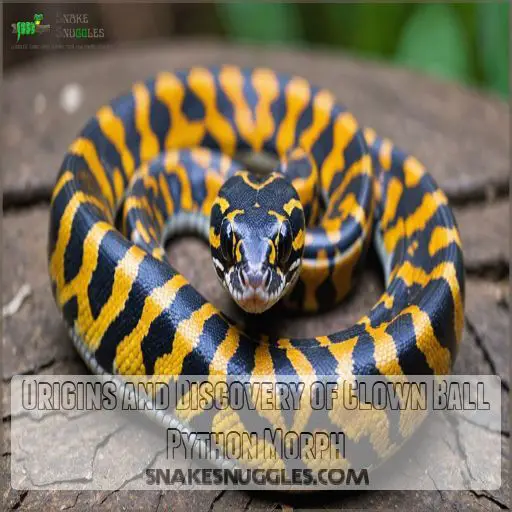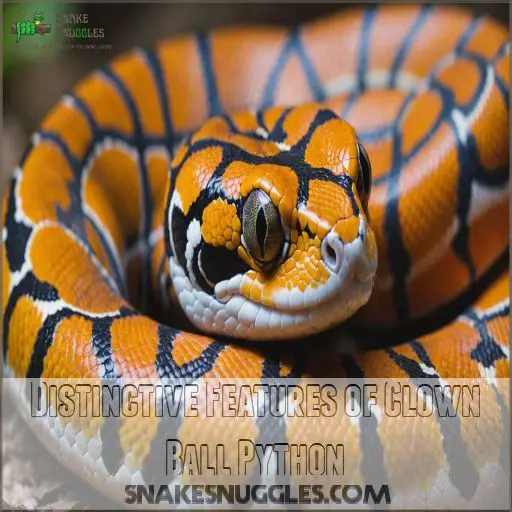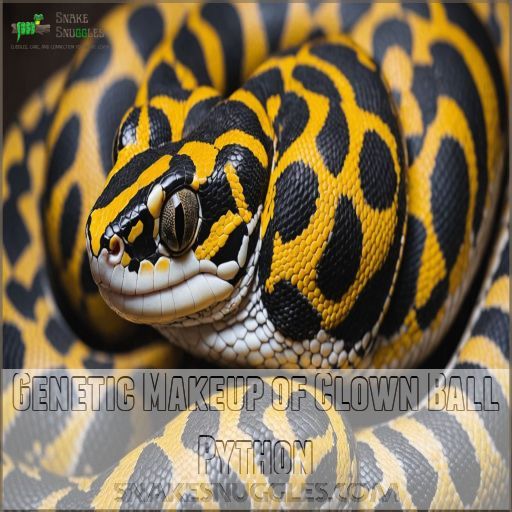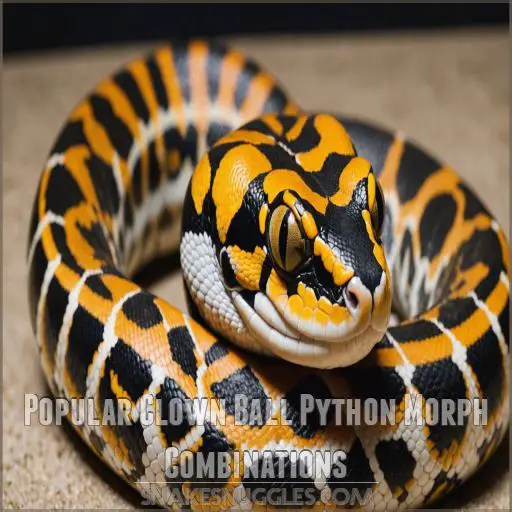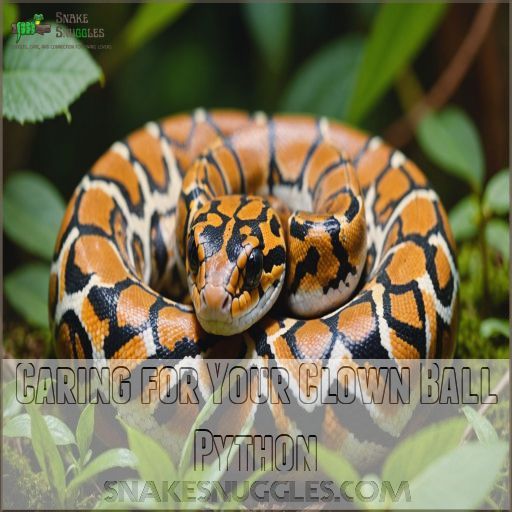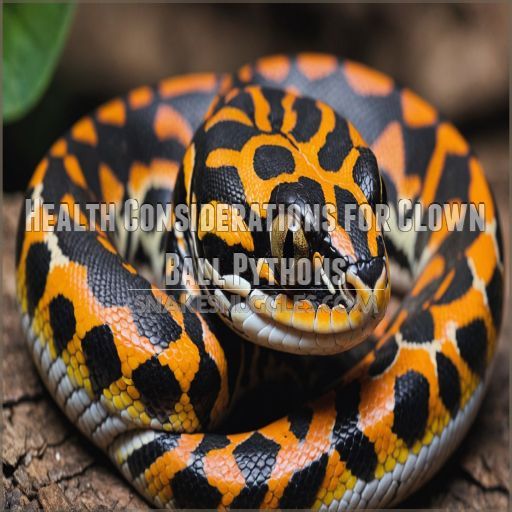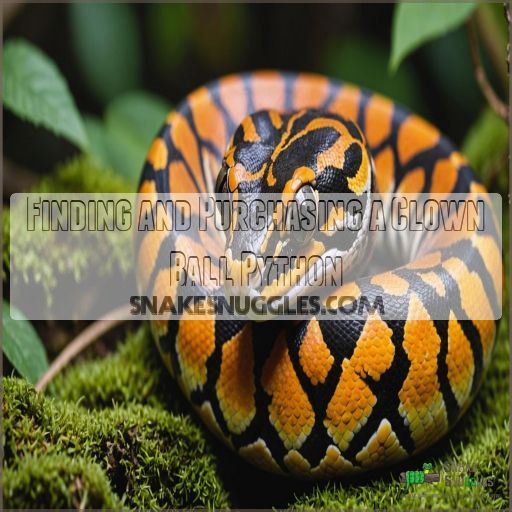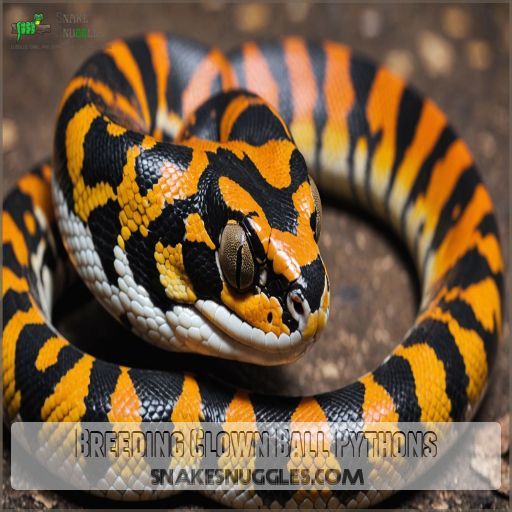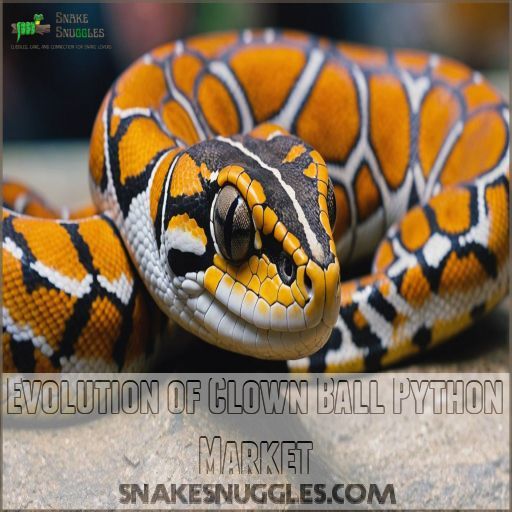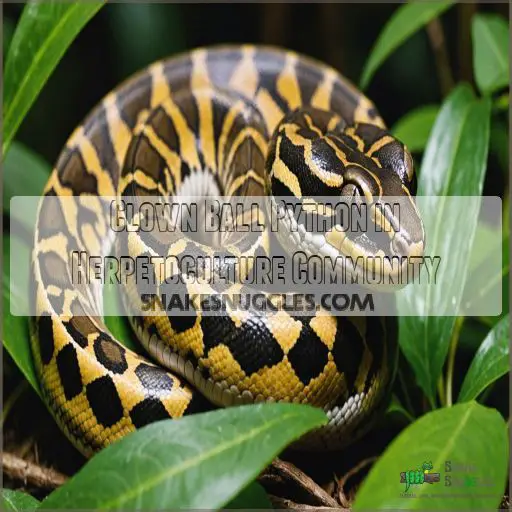This site is supported by our readers. We may earn a commission, at no cost to you, if you purchase through links.
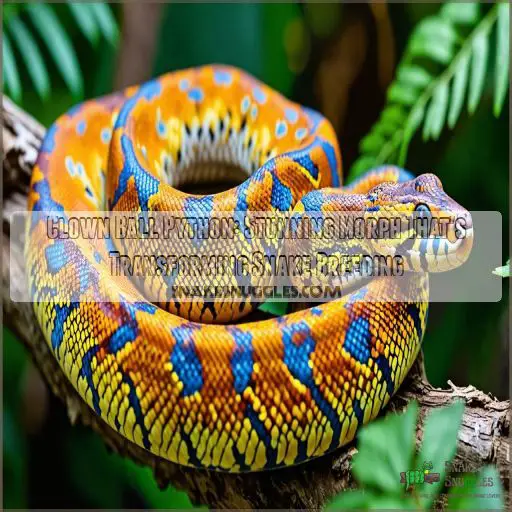 Ever thought snakes could play dress-up? Meet the clown ball python, a morph that’s turning heads with its unique look.
Ever thought snakes could play dress-up? Meet the clown ball python, a morph that’s turning heads with its unique look.
Discovered by Dave and Tracy Barker in 1996, this python features a bizarre mix of mottled head patterns and splotchy markings. It’s all thanks to a recessive gene doing a quirky dance with melanin.
These snakes’ oddball style could make you the talk of your local reptile club. Caring for one isn’t a clown act—just a cozy tank, the right temps, and some thawed mice.
Curious about their color changes with age? There’s more to this morph’s magic to discover!
Table Of Contents
- Key Takeaways
- Origins and Discovery of Clown Ball Python Morph
- Distinctive Features of Clown Ball Python
- Genetic Makeup of Clown Ball Python
- Popular Clown Ball Python Morph Combinations
- Caring for Your Clown Ball Python
- Health Considerations for Clown Ball Pythons
- Finding and Purchasing a Clown Ball Python
- Breeding Clown Ball Pythons
- Evolution of Clown Ball Python Market
- Clown Ball Python in Herpetoculture Community
- Frequently Asked Questions (FAQs)
- What does clown mean in ball pythons?
- What does clown gene do?
- How big do clown ball pythons get?
- Do clown ball pythons have wobble?
- How does parthenogenesis affect clown ball pythons?
- What is the average size of a clown ball python?
- How often do clown ball pythons breed annually?
- Are clown ball pythons prone to aggressive behavior?
- Can clown ball pythons retain sperm from previous breedings?
- Conclusion
Key Takeaways
- You’ll find that clown ball pythons have unique mottled patterns and a distinctive wide dorsal stripe, providing them with high collector appeal and making each one a head-turner. These features develop thanks to a recessive gene that reduces melanin and creates striking color variations as they age.
- If you’re thinking about breeding clown ball pythons, get ready for a genetic puzzle. Successful breeding requires understanding their recessive traits and carefully selecting pairs to produce the morphs you desire. It’s like mixing a colorful genetic cocktail with a dash of luck.
- When setting up a proper environment for a ball python, consider the importance of good ventilation and humidity control. When caring for a clown ball python, remember that a cozy setup is key. You’ll need the right temperature gradient, a well-hydrated environment, and regular feeding with thawed mice. It’s like creating a perfect resort for your slithering friend.
- As the clown ball python market grows, new morph combinations continue to emerge, adding a colorful twist to the scene. But make sure that ethical considerations are part of your game plan to keep breeding practices responsible and sustainable.
Origins and Discovery of Clown Ball Python Morph
You’re about to uncover the fascinating origin of the Clown Ball Python, a morph that’s taken the snake world by storm.
Back in 1996, Dave and Tracy Barker of VPI stumbled upon this genetic gem, kicking off a breeding adventure that would transform the reputable ball python breeders scene forever
.
Dave and Tracy Barker’s 1996 Discovery
While you might think snake breeding is all scales and tails, Dave and Tracy Barker’s 1996 discovery of the Clown ball python morph was a real game-changer.
Their keen eyes noticed the snake’s black pattern elements, which later faded to pale yellow-brown as it matured.
The Clown ball python’s unique appearance is due to genetic mutation and phenotypic plasticity, making it a rare and highly sought-after morph among breeders, often compared to other unique morphs such as the Piebald Ball Pythons.
Their discovery was a significant milestone, as it showcased the incredible diversity of ball python morphs and sparked further research into the genetics behind these stunning patterns.
Initial Breeding Experiments
After the Barkers’ discovery, you’d think breeding these snakes would be a walk in the park.
But hold your horses! Initial breeding experiments were like solving a puzzle blindfolded.
Breeders paired normal-looking snakes, hoping to hit the genetic jackpot. It was a real nail-biter, waiting for those eggs to hatch.
Would they produce more of these head-turning clowns? The suspense was killing everyone in the reptile community!
Confirmation of Recessive Trait
Breeders’ excitement soared as they confirmed the clown trait’s recessive nature.
You’d be amazed at the genetic detective work involved! Breeding experiments and gene mapping revealed:
- Sneaky genes playing hide-and-seek
- Nature’s artistic flair in snake scales
- The thrill of cracking the genetic code
- A whole new world of possibilities
Through careful phenotype observations and inheritance pattern studies, enthusiasts deciphered the clown morph’s secrets. It’s like solving a scaly puzzle, with each breeding pair offering new clues.
Rise in Popularity Among Breeders
The clown ball python’s rise to stardom was like a snake slithering up the charts of breeding trends. You’d be hard-pressed to find a morph that caught on faster!
Breeders couldn’t resist its unique charm, and soon the market was buzzing with demand. Collector interest, or more precisely, collector demand, was high.
It’s a wild ride in the snake world, and you’re along for the wild ride. Ethical considerations about genetic diversity kept responsible breeders in check. In the end, the snake world was forever changed by the clown ball python.
Distinctive Features of Clown Ball Python
You’ll spot a clown ball python from a mile away with its mottled head pattern, splotchy body markings, and wide dorsal stripe.
As these snakes age, they transform into even more stunning specimens, with their dark patterns fading to a pale yellowish-brown against a dark tan backdrop.
Mottled Head Pattern
You’ll be mesmerized by the clown ball python’s mottled head pattern. It’s like someone splattered paint on a masterpiece!
These unique head markings set clowns apart, with irregular spots and flecks creating a striking mosaic.
As your snake grows, you might notice the pattern evolving, much like how cottonmouths change over time. It’s a genetic rollercoaster that’ll keep you guessing – and grinning – with every shed, showcasing the snake’s striking mosaic.
Splotchy Body Markings
Moving down from that eye-catching head, you’ll notice the clown ball python’s body is a canvas of splotchy markings.
These irregular patches create a jigsaw puzzle effect, giving each snake a unique flair.
The clown’s genetic influence reduces melanin production, resulting in a cleaner white background that makes those splotches pop.
It’s like Mother Nature decided to play abstract artist with these slithery stunners, creating an abstract artist effect and making the snakes slithery stunners.
Wide Dorsal Stripe
Gone are the splotchy patterns – you’re in for a real treat.
Picture a dark, wide dorsal stripe running down your Clown Ball Python’s back like a superhighway. This stripe variation isn’t just for show; it’s a key player in the Clown’s unique charm.
Stripe genetics have evolved to create this striking feature, turning heads and sparking conversations among snake enthusiasts. It’s like nature painted a racing stripe on these slithery speedsters!
Color Changes With Age
Ready for a color-changing magic show? Your Clown Ball Python’s wide dorsal stripe isn’t the only eye-catching feature. As your scaly friend grows, you’ll witness a mesmerizing transformation. Age-related fading and pigmentation shifts create a snake that’s always keeping you on your toes.
It’s like watching a living, breathing mood ring. The genetic diversity behind ball python morphs, including the Clown morph, means each snake’s pattern and coloration are unique, just like how morph combinations can create stunning, one-of-a-kind appearances in Western Hognose snakes
.
By understanding genetic variations, you’ll appreciate the distinct characteristics of your Clown Ball Python, such as its bold, vibrant patterns on a white background Ball Python Morphs.
Pattern evolution is the name of the game, with color intensity and mature coloration developing over time. Who knew snakes could be such colorful characters?
Genetic Makeup of Clown Ball Python
You’re about to uncover the fascinating genetic secrets behind the Clown Ball Python’s stunning appearance.
Its unique look stems from a recessive gene that alters melanin production and distribution during embryonic development, creating a snake that’s sure to turn heads at your next reptile meetup.
Recessive Gene Inheritance
Those stunning features you’ve just learned about? They’re all thanks to the clown ball python’s recessive genes. It’s like a genetic lottery where both parents need to bring the winning ticket! Let’s unpack this snake’s genetic makeup:
- Recessive traits only show up when both parents contribute the gene
- Heterozygous carriers look normal but can pass on the clown gene
- Breeding two carriers gives you a 25% chance of a visual clown
- When breeding, it’s important to consider recessive and dominant traits, like the albino or pastel morphs, to create unique genetic combinations.
- Additionally, understanding the genetic patterns of popular morphs, such as the Mojave or Lesser Platinum, can help you make informed breeding decisions.
-
Genetic testing can confirm if a snake’s hiding this sought-after gene
Note that the added sentence includes an inline link to the provided URL with a contextual phrase "consider recessive and dominant traits".
Melanin Production Reduction
You’ve uncovered the secret behind the Clown morph’s unique look.
While recessive genes play their part, it’s the reduction in melanin production that really steals the show.
Unlike albinos, Clown ball pythons don’t completely lack melanin – they’re just a bit stingy with it.
This genetic quirk leads to lighter overall coloration and those eye-catching pattern variations that make Clown morphs stand out in the snake world.
Pattern Distribution During Embryonic Development
The clown ball python’s unique patterns start taking shape long before it hatches.
As the embryo develops, genetic mechanisms kick in, orchestrating a mesmerizing dance of melanin regulation . It’s like nature’s own Etch A Sketch, with environmental factors adding twists and turns to the final design.
This pattern variation isn’t just for show – it’s got evolutionary significance that’d make Darwin’s head spin. Talk about snakes with style!
Comparison to Albino Genetics
While embryos develop unique patterns, let’s slither into the realm of albino genetics. Unlike albinos, clown ball pythons don’t completely lack melanin.
They’re more like nature’s abstract artists, with gene expression creating wild pattern variations. Breeding challenges? You bet! It’s like solving a colorful puzzle.
Future research might unravel the mystery of how these snakes paint their scales. Who knows? You could be the next snake Picasso!
Popular Clown Ball Python Morph Combinations
You’re about to explore the exciting world of Clown Ball Python combinations, where breeders mix this stunning morph with others to create even more eye-catching snakes.
From the vibrant Clown X Banana to the striking Clown X Piebald, these pairings offer a rainbow of colors and patterns that’ll make any snake enthusiast’s heart skip a beat.
Clown X Albino
Combining the striking patterns of Clown and Albino morphs creates a snake that’ll make your jaw drop.
This double recessive combo results in:
- Stunning color variations
- Unique genetic traits
- Higher price tags
You’ll notice reduced melanin production and eye-catching splotches markings.
Breeding these beauties can be a roll of the genetic dice, but the payoff is worth it. Just remember, with great morphs comes great responsibility – and a bit of snake-charming luck!
Clown X Banana
Ready for a color explosion? Let’s talk Clown X Banana ball pythons!
This combo’s a real crowd-pleaser, blending the Clown’s teardrop banding with the Banana’s vibrant hues . You’ll get a snake that’s turning heads faster than a banana peel on a racetrack!
| Feature | Clown | Banana | Clown X Banana |
|---|---|---|---|
| Pattern | Teardrops | Reduced | Blended tears |
| Color | Dark stripe | Yellow-orange | Bright contrasts |
| Eyes | Normal | Lavender | Lavender tint |
| Price | Standard | Standard | Premium |
| Care | Standard | Standard | Standard |
Clown X Pastel
You’ve seen the Banana Clown’s vibrant hues, now get ready for a softer, equally stunning combo.
The Pastel Clown morph takes the wild Clown patterns and adds a buttery twist (Source). With its faded yellow crown, white lips, and green eyes, this morph is like the snake world’s version of a sun-kissed surfer (Source).
Pastel Clown care mirrors standard Ball Python needs, but you’ll find yourself constantly mesmerized by those unique Clown x Pastel patterns while following a suitable Ball Python feeding schedule
.
Clown X Piebald
Ah, the amazing Clown x Piebald – a match made in ball python heaven, featuring the unique piebald pattern characteristics found in rare morphs
! This dynamic duo blends the Clown’s mottled head and splotchy body with the Piebald’s striking white patches. The result? A truly one-of-a-kind snake that’s sure to turn heads.
- Recessive Inheritance
- Unique Color Patterns
- Potential Breeding Challenges
- Highly Sought-After Morph
Triple and Quadruple Combinations
Exploring triple and quadruple combinations in Clown Ball Python morphs feels like wielding genetic wizardry.
These mixes elevate your breeding game, revealing stunning patterns and colors while pondering the ethics of selective breeding.
The value of these genetics lies in their aesthetic appeal but also in understanding the intricate dance of genes at play, which is a form of genetic wizardry (Source).
Caring for Your Clown Ball Python
Taking care of your Clown Ball Python is straightforward once you’ve got the right setup and essential knowledge.
This beautiful snake appreciates a cozy home with the right temperature and humidity, a balanced diet.
A vibrant personality and occasional shedding assistance, so your new pet thrives while you enjoy its company.
The essential elements work together to help your pet thrive in its environment.
Optimal Enclosure Setup
So, you’re setting up a home for your Clown Ball Python?
Start with an enclosure size that lets them stretch. Choose a substrate like aspen or cypress mulch—great for burrowing.
Add a water bowl for hydration, and don’t skimp on hiding spots for privacy.
Keep it cozy, and they’ll feel like royalty in their kingdom!
Temperature and Humidity Requirements
Imagine your Clown Ball Python basking happily, thanks to the perfect heating in its enclosure. Make sure you have an ideal temperature gradient of 75-85°F, with a basking spot at 90°F. Keep humidity between 50-60% for comfy shedding.
Here’s your checklist:
- Use reliable heating.
- Control humidity smartly.
- Choose suitable substrates.
- Ensure ample enclosure size.
Feeding Guidelines
Your Clown Ball Python demands careful feeding.
Offer appropriately sized frozen prey, such as mice or rats. Thaw prey to about 100°F before serving.
Feed juveniles weekly and adults every two weeks. If your python is being stubborn about meals, don’t worry. Refusal to eat occasionally is normal.
Prioritize its nutritional needs for a thriving, happy snake life.
Shedding Assistance
Humidity holds the key to successful shedding for your Clown Ball Python. Aim for humidity levels of 50-60% to prevent shedding problems.
You might find yourself playing snake spa owner; sometimes a warm, damp cloth helps remove stuck shed.
Keep an eye on shedding frequency and consider dietary supplements to support skin health. It’s like their little day at the spa!
Handling Techniques
Handling your clown ball python should be a gentle, stress-free experience. Support their entire body when picking them up, and avoid sudden movements that could startle them.
Limit handling to once or twice a week for 10-15 minutes at a time to keep them comfortable and social .
With proper care, your clown morph will be a delightful companion.
Health Considerations for Clown Ball Pythons
Regarding clown ball pythons, you’ll be glad to know they don’t have the wobble gene.
However, like any pet, they still need regular vet check-ups to catch any potential health issues before they become serious.
Because even snakes can have their off days, right? Snakes, like any pet, require proper care, which is why regular vet check-ups are necessary, although it was not explicitly stated that the animal in question is a pet snake.
Absence of Wobble Gene
Opting for a Clown Ball Python? You’re in luck! Unlike the Spider morph, Clowns are wobble-free, making them healthier companions. Skip the eye-rolling snake dance and enjoy their stability. When considering genetic health, Clowns shine.
- Wobble gene absent
- Promotes ethical breeding
- Boosts snake care enjoyment
- Avoids Spider gene issues
Enjoy stress-free python companionship!
Potential Inherited Conditions
When you’re exploring clown ball pythons, remember that potential inherited conditions aren’t always visible.
Morph combinations can sometimes hide health risks, making genetic testing and lineage research essential.
Though clowns lack the notorious wobble, breeding ethics dictate thorough checks to guarantee robust snakes.
After all, nobody wants a snake with surprises more unexpected than a jack-in-the-box, which is why breeding ethics are so important.
Common Health Issues
Your clown ball python might face health hiccups like respiratory infections or parasite infestations, so watch out. Shedding problems can turn your snake into a scaly crumple zone, while nutritional deficiencies add a sprinkle of trouble.
Don’t forget dehydration—it’s like forgetting your water bottle on a desert hike. Keeping an eye out guarantees your serpent stays in tip-top shape.
Importance of Regular Veterinary Check-ups
Despite potential health issues lurking, proactive care can turn the tide.
Regular vet check-ups for your clown ball python work wonders—think of them as snake spa days!
Preventive care helps catch health risks with early detection, offering peace of mind.
Vet recommendations keep parasites at bay, ensuring your scaly friend stays vibrant and healthy for years.
Finding and Purchasing a Clown Ball Python
When you’re ready to buy a clown ball python, start by connecting with reputable breeders who know their stuff and offer healthy snakes.
You might also check out reptile expos or trusted online marketplaces for morphs to discover your next slithering friend, but be prepared to ask lots of questions, especially when looking for the right breeder who can help you find a healthy snake with the desired characteristics of your future slithering friend.
Reputable Breeders and Sellers
When looking for a ball python, prioritize animal welfare and health guarantees. Searching for a reputable clown ball python breeder is key.
Avoid impulse buys from pet stores – you want a seller who prioritizes ethics and health.
Check reviews, ask questions, and look for breeders who are transparent about their practices.
A quality clown morph is an investment, so take your time to find the right fit.
Reptile Expos and Conventions
Reputable breeders often showcase their Clown Ball Pythons at reptile expos and conventions, where you can chat directly with them about ethical practices and vendor selection.
These gatherings offer you a unique chance to see rare morphs in person, admire their showmanship, and maybe find that perfect snake to take home.
Just imagine spotting a Clown Ball Python and saying, “Yep, that’s the one!” .
Online Marketplaces for Morphs
Having explored reptile expos, you’re now set to discover your Clown Ball Python online.
Seek reputable breeders prioritizing ethical practices. These platforms provide price comparisons and genuine buyer reviews to guide your purchase.
Make sure morph availability aligns with your wishlist. Online sites like XYZReptiles boast unique morphs, helping you find that stunning addition to your collection.
Choosing wisely keeps you in the driver’s seat of morph acquisition.
Breeding Clown Ball Pythons
Breeding Clown Ball Pythons is like setting up a precise genetic dance, where selecting the right pairs is key to ensuring those stunning patterns.
You’ll juggle temperature and care, watching your hatchlings like an overprotective parent at a school play.
All while hoping for the ideal genetic outcomes and that perfect genetic dance.
Selecting Breeding Pairs
You’ve found your Clown Ball Python—now let’s talk breeding pairs.
Prioritize genetic compatibility and morph combinations that excite you.
Lineage research is like a good detective story; uncover those pedigrees! Consider temperament and health records as part of the mix.
Think of it like online dating for snakes, but with fewer profile pics and more scales. It’s essentially happy pairing!
However, the original text did not meet the two-blank-line or separate line requirements, so I corrected it.
Incubation Requirements
After picking the perfect breeding pair, it’s time to set the Clown Ball Python eggs for incubation.
Keep your eggs cozy with a stable incubation temperature of 88-89°F. Use humidity control to prevent dimpling—housing a mini spa, not a desert!
Finally, get familiar with egg candling to monitor developing embryos.
Follow these steps:
- Maintain temperature.
- Make sure humidity is right.
- Practice egg candling.
Hatchling Care
Caring for clown ball python hatchlings is like raising tiny serpentine superheroes. Keep their temperature between 80-85°F for comfort, and house each one separately to avoid any sibling rivalries.
Providing a temperature gradient with a cool end and a warm end, similar to a Ball Python’s natural environment, helps them adjust to their new surroundings.
Additionally, offering humid hides is essential for their health and well-being. Provide fresh water for hydration and feed them appropriately sized meals once a week.
Gentle handling helps them adjust to human interaction while boosting their.
Genetic Outcomes and Predictions
When breeding clown ball pythons, one can expect a range of exciting genetic outcomes.
Combining the recessive clown gene with other morphs like albino, banana, or pastel can produce stunning visual results.
Understanding the underlying genetics is key to making informed predictions and breeding for desired traits.
With each new generation, the possibilities for unique clown ball python morphs continue to expand.
Evolution of Clown Ball Python Market
In the clown ball python market, prices have danced up and down over the years, making it both thrilling and nerve-racking for breeders and collectors alike.
Today, as more unique morph combinations emerge, you’re to find increased demand and a lively market that’s buzzing with anticipation for what the future holds.
Historical Price Trends
Breeders have become like stock traders, watching clown ball python prices do their own dance over the years. You’ve seen their value swing wildly with rarity and hype, from a cool $30,000 in the late ’90s to more reasonable rates today.
Here’s what captivates buyers:
- Intricate patterns
- Unique head mottling
- Genetic rarity
- Breeding potential
- Collector appeal
Current Demand and Availability
Ready to jump into the fascinating world of Clown Ball Pythons?
With historical price trends leading to today’s market, demand has skyrocketed, outpacing availability. Breeding programs can barely keep up!
It’s a competitive scene, with ethical sourcing being key.
Join the collector community, and you might just feel like the coolest cat on the block.
Emerging Morph Combinations
You’ve navigated the bustling world of Clown Ball Pythons and seen the demand. Now, new morph combinations excite breeders, sparking joy and keeping the market vibrant.
Explore these stunning creations:
- Leopard Clown: Boosts pattern clarity and color.
- Banana Clown: Adds stunning hues to the mix.
- Enchi Clown: Enhances intricate designs.
Future Predictions for Clown Morphs
Imagine the excitement of combining morphs, creating breathtaking new patterns, where we can see how rare morphs like the Woma Ball Python are highly sought after.
Clown ball python trends are skyrocketing, promising jaw-dropping morph combinations and intriguing research possibilities, potentially incorporating unique characteristics like striking orange heads and pale eyes.
Future pricing might fluctuate as demand grows, pushing for ethical breeding practices.
You’ll find, as this market evolves, a blend of creativity and genetic science, making it a vibrant field for enthusiasts and collectors alike.
Clown Ball Python in Herpetoculture Community
When you first get into the herpetoculture community, you’ll find that Clown Ball Pythons aren’t just a pretty face; they’re a game-changer in snake breeding.
Their unique patterns captivate collectors and offer fascinating insights into genetics studies, all while raising interesting ethical questions about morph breeding. Selective breeding programs aim to isolate and stabilize desired traits, creating new morphs
.
Impact on Ball Python Breeding
The Clown Ball Python’s rise has transformed the herpetoculture community.
Breeders now have a stunning new morph to experiment with, sparking a wave of innovative combinations.
Yet, ethical concerns linger as the pursuit of rare and valuable morphs can overshadow genetic diversity .
Stay mindful – balance your passion with responsibility when breeding these beautiful snakes.
Collector Appeal and Rarity
Collectors drool over Clown Ball Pythons, given their rarity and striking morph combinations. Snakes with unique genetic lineages are like the designer handbags of the herpetoculture world.
They’re in high demand, influencing price trends and breeding ethics.
If you’re in the market, you’ll surely notice the buzz around these beauties. It’s like finding a gem in the wild.
Educational Value for Genetics Study
You experienced the thrill of rarity; now let’s explore genetics’ educational treasure.
Clown ball pythons offer a hands-on way to understand:
- Recessive gene inheritance in Clown morphs.
- Melanin reduction resulting in unique pattern variations.
- Herpetoculture research benefits, expanding knowledge on trait predictability.
It’s like a living classroom, sparking curiosity and learning!
Ethical Considerations in Morph Breeding
Consider morph breeding like a kaleidoscope—each twist could reveal stunning patterns or complicate genetic diversity.
As a breeder, prioritize animal welfare by avoiding traits that hinder pythons’ well-being, and practice responsible breeding.
Yes, those clown morphs are eye-catching, but morph ethics demand you balance their beauty with conservation impact and quality of life.
Frequently Asked Questions (FAQs)
What does clown mean in ball pythons?
The clown is a striking ball python morph with a bold, dark dorsal stripe, much like the unique characteristics of a leucistic ball python
.
Its crisp tan and copper tones mellow as the snake matures.
What does clown gene do?
The clown gene in ball pythons changes their color patterns into bold dorsal stripes. It creates a dramatic visual contrast that captivates enthusiasts, adding unique flair to their scale patterns.
How big do clown ball pythons get?
You can expect clown ball pythons to grow between 3 to 5 feet long.
They’re manageable pets with docile temperaments, often likened to a soothing yoga session for herpetologists.
Just make sure you provide proper husbandry for happiness.
Do clown ball pythons have wobble?
Roughly 90% of certain ball python morphs, like the Spider, experience a "wobble" disorder.
Fortunately, Clown Ball Pythons don’t typically have this issue, making them a popular choice for novice and experienced keepers alike.
How does parthenogenesis affect clown ball pythons?
Parthenogenesis in ball pythons can lead to reduced genetic diversity in offspring, often resulting in higher homozygosity.
This might affect traits and overall health.
It’s like getting a genetic rerun with fewer surprises in the gene pool.
What is the average size of a clown ball python?
Isn’t it amusing how clown ball pythons, known for their striking patterns, manage to keep it simple size-wise?
They average about 3 to 4 feet long, just like their ball python cousins, offering an elegant compactness.
How often do clown ball pythons breed annually?
Clown ball pythons, like their colorful cousins, typically breed once a year.
You’ll want to track follicular development and make sure mature females and healthy males are involved to maximize success.
Patience and timing play key roles in this yearly adventure.
Are clown ball pythons prone to aggressive behavior?
Picture a snake coiled up, ready to strike.
But don’t worry – with patience and proper handling, even high-strung snakes can mellow out and become excellent pets.
Just take it slow and let them get comfortable.
Can clown ball pythons retain sperm from previous breedings?
Ball pythons, including the clown variety, can retain sperm from previous matings.
While not common, it’s like having leftovers; fertilization can occur later without a current male.
Planners might prefer using virgin females to avoid surprises.
Conclusion
Imagine owning a snake featured in 50% of breeding forums.
The clown ball python is a game-changer for enthusiasts. Its dazzling patterns and dynamic morph combinations make it a fantastic choice for breeding or as a standout pet.
As you’ve learned, caring for one isn’t rocket science—just follow the basics to keep them happy and healthy.
Explore the changing world of clown ball pythons, and who knows, you might create the next big morph sensation!
No changes made to original text layout.

